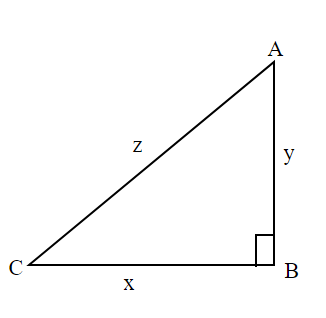
A person wishes to fit three rods together in the shape of a right-angled triangle so that the hypotenuse is to be $4cm$ longer than the base and $8cm$ longer than the altitude. The length of the rods is:
A) $3cm,4cm,5cm$
B) $1.5cm,2cm,2.5cm$
C) $6cm,8cm,10cm$
D) $12cm,16cm,20cm$
Answer
566.4k+ views
Hint: First assume the lengths of the base, altitude and hypotenuse. Use the Pythagoras theorem which states that the square of the length of the hypotenuse is equal to the sum of the square of the length of the base and the altitude.
Complete Step-by-Step solution:
Draw a figure of three rods which are in the shape of a right-angled triangle.

Assume the length of the hypotenuse AC is $z$, length of the base BC is $x$ and the length of the altitude AB is $y$.
We are given that the hypotenuse is to be $4cm$ longer than the base and $8cm$ longer than the altitude.
Therefore,
$
z = x + 4.....(1) \\
z = y + 8.....(2) \\
$
Compare both the equations to get the relation between $x$ and $y$.
$
x + 4 = y + 8 \\
y = x - 4........(3) \\
$
Now we use the Pythagoras theorem.
Pythagoras theorem states that the square of the length of the hypotenuse is equal to the sum of the square of the length of the base and the altitude.
Therefore,
${z^2} = {x^2} + {y^2}$
Substitute the value of $y$ from equation $(3)$ and the value of $z$ from equation $(1)$
Therefore,
${(x + 4)^2} = {x^2} + {(x - 4)^2}$
Use the algebraic identities
$
{(a + b)^2} = {a^2} + 2ab + {b^2} \\
{(a - b)^2} = {a^2} - 2ab + {b^2} \\
$
Rewrite the above equation after using the identities.
$
{x^2} + 16x + 16 = {x^2} + {x^2} - 16x + 16 \\
{x^2} - 16x = 0 \\
x(x - 16) = 0 \\
x \ne 0 \\
\therefore x - 16 = 0 \\
x = 16 \\
$
Substitute the value of $x$ in equation $(1)$and $(3)$
$
y = x - 4 \\
y = 16 - 4 \\
y = 12 \\
$
$
z = x + 4 \\
z = 16 + 4 \\
z = 20 \\
$
Hence, the length of the rods is $12cm,16cm,20cm$
Therefore, option (D) is correct.
Note:
There is an alternate approach to solve this question which is given below:
If we look at our condition that the hypotenuse is to be $4cm$ longer than the base and $8cm$ longer than the altitude and we know that hypotenuse is the largest length of the right-angled triangle.
Complete Step-by-Step solution:
Draw a figure of three rods which are in the shape of a right-angled triangle.

Assume the length of the hypotenuse AC is $z$, length of the base BC is $x$ and the length of the altitude AB is $y$.
We are given that the hypotenuse is to be $4cm$ longer than the base and $8cm$ longer than the altitude.
Therefore,
$
z = x + 4.....(1) \\
z = y + 8.....(2) \\
$
Compare both the equations to get the relation between $x$ and $y$.
$
x + 4 = y + 8 \\
y = x - 4........(3) \\
$
Now we use the Pythagoras theorem.
Pythagoras theorem states that the square of the length of the hypotenuse is equal to the sum of the square of the length of the base and the altitude.
Therefore,
${z^2} = {x^2} + {y^2}$
Substitute the value of $y$ from equation $(3)$ and the value of $z$ from equation $(1)$
Therefore,
${(x + 4)^2} = {x^2} + {(x - 4)^2}$
Use the algebraic identities
$
{(a + b)^2} = {a^2} + 2ab + {b^2} \\
{(a - b)^2} = {a^2} - 2ab + {b^2} \\
$
Rewrite the above equation after using the identities.
$
{x^2} + 16x + 16 = {x^2} + {x^2} - 16x + 16 \\
{x^2} - 16x = 0 \\
x(x - 16) = 0 \\
x \ne 0 \\
\therefore x - 16 = 0 \\
x = 16 \\
$
Substitute the value of $x$ in equation $(1)$and $(3)$
$
y = x - 4 \\
y = 16 - 4 \\
y = 12 \\
$
$
z = x + 4 \\
z = 16 + 4 \\
z = 20 \\
$
Hence, the length of the rods is $12cm,16cm,20cm$
Therefore, option (D) is correct.
Note:
There is an alternate approach to solve this question which is given below:
If we look at our condition that the hypotenuse is to be $4cm$ longer than the base and $8cm$ longer than the altitude and we know that hypotenuse is the largest length of the right-angled triangle.
Recently Updated Pages
The height of a solid metal cylinder is 20cm Its r-class-10-maths-ICSE

If a train crossed a pole at a speed of 60kmhr in 30 class 10 physics CBSE

Name the Writs that the High Courts are empowered to class 10 social science CBSE

A tower is 5sqrt 3 meter high Find the angle of el-class-10-maths-CBSE

Immediate cause of variations of A Mutations B Environmental class 10 biology CBSE

A rectangular container whose base is a square of side class 10 maths CBSE

Trending doubts
Why is there a time difference of about 5 hours between class 10 social science CBSE

Why is Sardar Vallabhbhai Patel called the Iron man class 10 social science CBSE

Tropical deciduous trees shed their leaves in the dry class 10 social science CBSE

The Equation xxx + 2 is Satisfied when x is Equal to Class 10 Maths

Write a letter to the principal requesting him to grant class 10 english CBSE

Leap year has days A 365 B 366 C 367 D 368 class 10 maths CBSE




